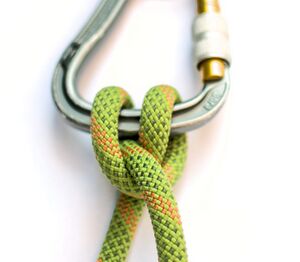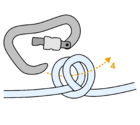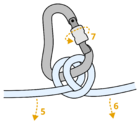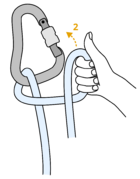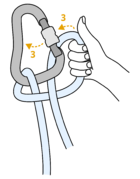Clove hitch: Difference between revisions
Added reference list location |
|||
| Line 68: | Line 68: | ||
In case of a dynamic rope around a carabiner, the clove hitch generally does not slip till ~6 kN. Chance of slipping is higher if the clove hitch is tied around a big-diameter object (tree, smooth stone), and with static ropes. With 8mm dyneema sling around a carabiner there is a report of slow slippage already ~3 kN of force. For list of values, see the table on right<ref>{{cite web | url=https://edelrid.com/eu-en/knowledge/knowledge-base/strength-reduction-of-textile-materials-by-knots | title=Strength reduction of textile materials by knots | publisher=EDELRID GmbH & Co. KG | author=EDELRID Team | date=20 October 2020 | website=edelrid | access-date=10 August 2025}}</ref>. Therefore the clove hitch should be backed-up by another knot in critical applications, for example in cases where it might slip off the end of the sling/rope. | In case of a dynamic rope around a carabiner, the clove hitch generally does not slip till ~6 kN. Chance of slipping is higher if the clove hitch is tied around a big-diameter object (tree, smooth stone), and with static ropes. With 8mm dyneema sling around a carabiner there is a report of slow slippage already ~3 kN of force. For list of values, see the table on right<ref>{{cite web | url=https://edelrid.com/eu-en/knowledge/knowledge-base/strength-reduction-of-textile-materials-by-knots | title=Strength reduction of textile materials by knots | publisher=EDELRID GmbH & Co. KG | author=EDELRID Team | date=20 October 2020 | website=edelrid | access-date=10 August 2025}}</ref>. Therefore the clove hitch should be backed-up by another knot in critical applications, for example in cases where it might slip off the end of the sling/rope. | ||
== References == | |||
{{reflist}} | |||
</translate> | </translate> | ||
Revision as of 17:18, 10 August 2025
Clove hitch is an essential knot used in many occasions when adjustable reliable knot is needed and thus finds its place in most of the knotting operations during climbing such as anchor building, offsetting belay station for belaying of the second climber, or self-attaching of the lead climber with a rope to the anchor point.
Tying
Easy method
This method is very robust and suitable for learning how to tie the hitch.
Steps description: start with making a two identical loops on a rope (1,2). Then place one loop over the other in a way that the end-ropes are surrounded by the rope between the loops (3). Pull a carabiner through the loops (4). Tighten the knot by sequentially pulling on the ends a few times and lock the gate (5,6,7). At the end, do not forget to inspect the hitch and the gate lock (8).
One-hand method
Non-crucial, but handy once you have only one hand free.
Steps description: Start with a rope through a carabiner. Grab the rope strand which runs from the back of the carabiner with your hand thumb pointing down and rotate the hand into a thumb-up position (1). Open the gate (2) and pull the rope through the gate from the front to back and seat the rope into the carabiner, the gate closes itself automatically (3). Sequentially pull the rope strands to tighten the knot (4,5) and screw the safety-lock (5). Inspect that the knot is tied properly and that the gate is locked (7).
Quick repositioning
One of the strongest points of the clove hitch is its quick repositioning without cancelling the setup or opening the carabiner.
Steps description: Pull the middle strand between the two loops (1). By this you loosen the knot and pull the rope from the both sides. Then pull one of the strands, re-tightening and repositioning the knot in the process (2).
Slippage
| Material | Force (kN) |
|---|---|
| 7.9 mm 1/2 rope | 6.5 |
| 8.9 mm triple-rated rope | 7.8 |
| 8 mm Dyneema® | 3.0 |
| 11 mm Dyneema® | 5.1 |
| 19 mm polyamid | 10.1* |
| 6 mm accessory cord | 6.9 |
this section is not yet inspected thoroughly, statements might be incorrect and/or misleading!
In case of a dynamic rope around a carabiner, the clove hitch generally does not slip till ~6 kN. Chance of slipping is higher if the clove hitch is tied around a big-diameter object (tree, smooth stone), and with static ropes. With 8mm dyneema sling around a carabiner there is a report of slow slippage already ~3 kN of force. For list of values, see the table on right[1]. Therefore the clove hitch should be backed-up by another knot in critical applications, for example in cases where it might slip off the end of the sling/rope.
References
- ↑ EDELRID Team (20 October 2020). "Strength reduction of textile materials by knots". edelrid. EDELRID GmbH & Co. KG. Retrieved 10 August 2025.
